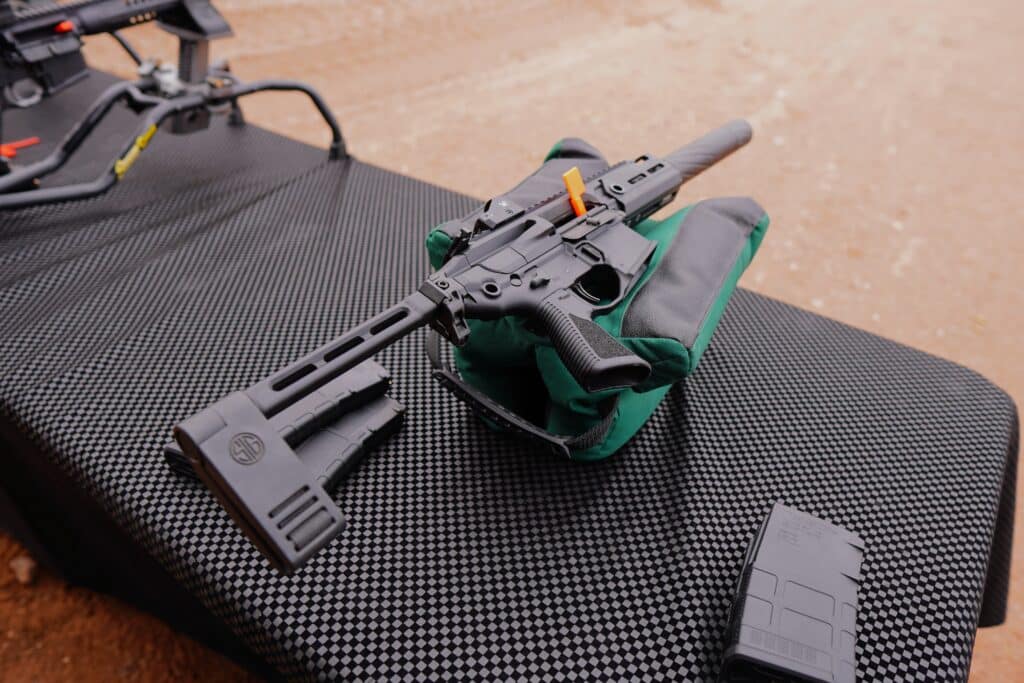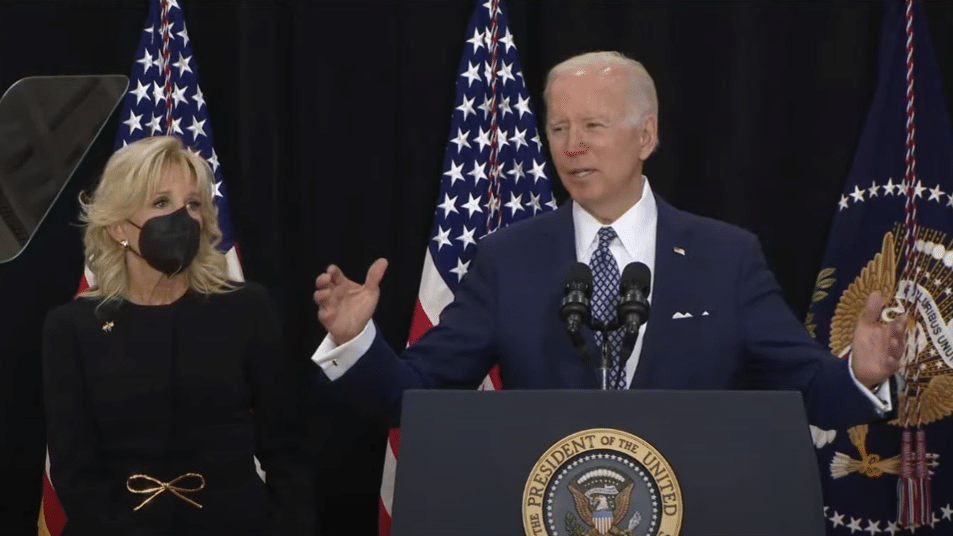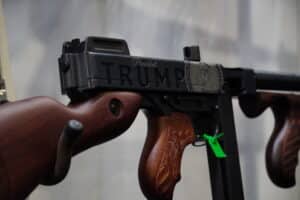And what about other accessories?
President Joe Biden’s attempt to use the ATF to reclassify guns equipped with pistol braces as NFA items and potentially prosecute anyone who doesn’t comply has been tossed. But, as I explain below, this rule and the other ones thrown out recently aren’t falling because of the Second Amendment. Instead, they’re running up against the limits of executive agency power.
However, there’s reason to think the pistol-brace ban might be unconstitutional because it violates the right to keep and bear arms. Contributing Writer Jake Fogleman examines one judge’s argument for why and the implications it has for other gun accessories.
Plus, National Review’s Charles Cooke joins the podcast to talk about President Biden’s gun agenda’s legal losing streak. And I talk a bit about my visit to the Guns Out TV range day!

Analysis: Does the Second Amendment Protect Gun Accessories? [Member Exclusive]
By Jake Fogleman
President Joe Biden’s attempt to heavily restrict pistol braces was tossed this week for pushing the ATF’s authority beyond its limits. But at least one judge thinks the accessories might also be protected by the Second Amendment.
On Tuesday, Judge Don Willett of the Fifth Circuit Court of Appeals joined a ruling that found Biden’s pistol-brace ban crossed the line from enforcing current law into legislating. The majority said the rule, like several other ATF policies before it, violated the Administrative Procedure Act (APA) and can’t stand. The panel decided not to address Second Amendment claims since the plaintiffs won on their APA claim.
But Judge Willett wrote separately to contend the firearm accessories are probably protected under the right to keep and bear arms.
“Rearward attachments, besides making a pistol less concealable, improve a pistol’s stability, and thus a user’s accuracy. Accuracy, in turn, promotes safety,” Willett wrote in a concurrence. “In my view, protected Second Amendment ‘conduct’ likely includes making common, safety-improving modifications to otherwise lawfully bearable arms.”
While Willett’s framework is merely an early exploration of the issue and, as a concurrence, holds limited precedential value, it does offer insight into how other courts may confront similar issues. In particular, his focus on “safety-improving modifications” to legal firearms would seem to have implications beyond just pistol braces.
“Assault weapon” bans, for instance, are routinely drafted to differentiate certain classes of semi-automatic firearms based solely on cosmetic or ergonomic features such as pistol grips and adjustable stocks. Without such features, most weapons covered under these bans are otherwise legal to own. Yet, when equipped with them, they become prohibited despite, in many cases improving the shooting experience and, thus, stability and accuracy of the weapon for its owner. According to Willett, this distinction could implicate the Second Amendment test established by the Supreme Court in New York State Rifle and Pistol Association v. Bruen.
“Remember: ATF agrees that the weapons here are lawfully bearable pistols absent a rearward attachment. Congress might someday try to add heavy pistols to the NFA and the GCA, but it hasn’t yet. These pistols are therefore lawful,” Willett wrote. “Adding a rearward attachment—whether as a brace or a stock—makes the pistol more stable and the user more accurate. I believe these distinctions likely have constitutional significance under Bruen.”
He even cast doubt over the constitutionality of the National Firearms Act of 1934 (NFA), which regulates short-barrel rifles (SBRs), silencers, and machineguns.
“Even for attachments that convert a pistol into a rifle under the statutes, ATF has not identified any historical tradition of requiring ordinary citizens to endure a lengthy, costly, and discretionary approval process just to use accessories that make an otherwise lawful weapon safer,” he added. “Instead, the NFA tends to regulate weapons that inflict indiscriminate destruction.”
He noted that while determining conclusively whether the Biden administration’s rule violated the Second Amendment was unnecessary in this case, it was likely that “the constitutional questions may soon return.”
To be sure, even if the Second Amendment case against the ban does return, there is no guarantee that the Fifth Circuit or any other federal court will necessarily see it the same way. Indeed, there are already indications that some members of his own court do not share Judge Willett’s view. Judge Stephen A. Higginson, who authored a dissenting opinion against the panel’s holding that the ban violated the APA, also wrote separately to dispute the Second Amendment case for striking down the ban.
“I disagree that these braces are, in relevant regard, ‘safety-improving modifications,’” Higgenson wrote. “Increased concealability and accuracy, at least in the hands of killers, is not ‘safe’—it is lethal.”
Instead, Higginson relied on a combination of dicta from Heller and his interpretation of the “common use” test to arrive at the conclusion that braced pistols—deemed SBRs by the federal government—are too dangerous and unusual to be covered by the text of the Second Amendment.
“Until told otherwise by the Supreme Court, I am persuaded that uniquely dangerous weapons, including short-barreled rifles, are not covered by the Second Amendment,” he added. “That’s because there is a historical tradition of prohibiting the carrying of ‘dangerous and unusual weapons.’ And the Supreme Court’s more recent decision in Bruen left Heller’s dangerous-and-unusual carveout intact.”
But while Higginson said his objections arose from following Supreme Court precedent, he did so in a way that the current Court would likely disagree with. Reasonable legal minds can differ over whether braced pistols represent a safety improvement or are, instead, particularly dangerous. The case that they are also unusual is much harder to make.
In its impact assessment for the rule, the ATF itself estimated that three to seven million pistol braces were in civilian circulation. Meanwhile, the Congressional Research Service indicated they were far more commonly owned, with estimates of between 10 to 40 million in civilian hands.
Ultimately, it may not matter what the Second Amendment implications of the pistol brace ban actually are. The administrative law weaknesses of the ATF’s rule, much like its frame and receiver and bump stock bans, may ultimately carry the day before a Second Amendment case against the ban similar to Judge Willett’s can be fully fleshed out.
Nevertheless, Willett’s argument on Second Amendment protections for accuracy and safety-improving modifications to otherwise legal firearms offer a glimpse into how some judges might view the scope of the right to keep and bear arms. It’s an idea that could have implications far beyond pistol braces.
Podcast: National Review’s Charles Cooke on the Courts Dismantling President Biden’s Gun Agenda [Member Early Access]
By Stephen Gutowski
The last domino to fall in President Joe Biden’s gun agenda was toppled by a Fifth Circuit panel.
So, we’re bringing one of the best political writers in the country. Nationals Review’s Charles Cooke is one of the top conservative analysts on both the legal and political side of guns in America. He joins the show to talk about why Biden’s pistol-brace ban was tossed.
Hint: It wasn’t because of the Second Amendment.
Instead, Cooke noted the courts have objected to the ATF overstepping its bounds when creating Biden’s gun policies. He said that fact makes it very likely the Supreme Court would object on the same grounds. That’s because, as presidents from across the political spectrum have taken to expanding the power of executive agencies, the Court has begun to pair back agency overreach.
Cooke argued the losing streak is bad for President Biden’s reelection. Despite what’s shaping up to be an unprecedented 2024 election, which seems likely to include bump stock ban originator Donald Trump, Cooke said the constitutionally-deficient policies will drag Biden down. Especially because the majority of people who’ve heard about them are the ones they negatively affect.
Plus, Contributing Writer Jake Fogleman and I talk about how a Memphis school’s security procedures stopped a mass shooting.
You can listen to the show on your favorite podcasting app or by clicking here. Video of the episode is available on our YouTube channel. Reload Members get access on Sunday, as always. Everyone else can listen on Monday.
Guns Out Range Day
I went back out to XCal in Loudon County, Virginia on Saturday. This time I was checking out the range day put on by Guns Out TV.
It was quite the event. Lots of people and vendors. Plus, they had a raffle and shooting competitions. Some of the stuff on sale there was really unique and impressive, like these cases from Carolina Custom Foam.
You might recognize Guns Out TV if you’ve been a Reload Member from the early days. I profiled hosts Shermichael Singleton and John Keys back in 2021. They’ve only grown since then, just like the community of previously-underrepresented gun owners they’re emblematic of.
I was able to jump onto their podcast for an interview too. So, keep an eye out for when that drops. You can check out the previous episodes here.
I also go to say hi to the guys from IraqVeteran8888 and check out their new gun company Argos Ordnance. I didn’t get a chance to shoot the AR-15s they’re building, so I can’t review them. But those guys know their guns, and they seem to have put together a well-thought-out configuration.
So, hopefully, I do get to shoot it in the near future. Perhaps at the next Guns Out Range Day, which will hopefully happen again soon.
Also, I ended up buying this cool pmag too. It was a good event.

Analysis: Second Amendment Isn’t What’s Sinking Biden’s Gun Actions [Member Exclusive]
By Stephen Gutowski
The federal courts have quickly dismantled President Joe Biden’s gun agenda over the past few months. And they’ve done it without citing Second Amendment protections.
At first glance, this seems odd since the Supreme Court broadened what kind of conduct is protected by the amendment during the same period. In 2022’s New York State Rifle and Pistol Association v. Bruen, SCOTUS found the Second Amendment protected public gun carry in the same way gun ownership is protected under 2008’s District of Columbia v. Heller. Since then, federal courts have blocked multiple ATF rules seeking to reclassify, restrict, or ban bump stocks, unfinished gun parts, and firearms equipped with pistol braces.
But none of those rulings were decided by the outcome of Bruen or the test it created for judging the constitutionality of gun laws. Instead, the majority opinions all focused on the ATF’s legal maneuvering in the leadup to and adoption of the rules. That has been the weak point in the Biden Administration’s attempts to enact or defend ATF rulemaking that unilaterally attempted to rework America’s gun laws.
On Tuesday, a Fifth Circuit panel ruled the Firearms Policy Coalition and other plaintiffs were likely to win their case against Biden’s pistol-brace ban. The panel sent the case back down to a lower court for a preliminary injunction to be issued against the ATF rule. It did so because the two-to-one majority said the ATF failed to properly follow the Administrative Procedure Act (APA) when crafting the policy.
“The Final Rule affects individual rights, speaks with the force of law, and significantly implicates private interests,” Judge Jerry E. Smith wrote for the majority in Mock v. Garland. “Thus, it is legislative in character.”
Being legislative, the panel found the agency would have to go through the rulemaking required by the APA. The ATF attempted to do that, but the majority found that attempt was severely lacking. Their issue stemmed primarily from the agency’s drastic changes to the rule after it had gone through the public comment period.
“[N]owhere in the Proposed Rule did the ATF give notice that it was considering getting rid of the Worksheet for a vaguer test,” Judge Smith wrote. “Instead, the ‘Comments Sought’ section of the Proposed Rule requested only ‘additional criteria that should be considered’ and comments on whether the ATF ‘selected the most appropriate criteria.’ Proposed Rule at 30850. Removing all objective criteria operates a rug-pull on the public.”
The Second Amendment is not mentioned anywhere in the majority’s reasoning. That’s despite it being part of the plaintiffs’ claims, the concurrence, and the dissent in the case. But that should come as no surprise because the same was true for the ruling against President Biden’s “ghost gun” ban.
Early last month, Federal District Court Judge Reed O’Connor found that ATF rule overstepped its authority under the APA and was, therefore, unlawful.
“This case presents the question of whether the federal government may lawfully regulate partially manufactured firearm components, related firearm products, and other tools and materials in keeping with the Gun Control Act of 1968,” Judge O’Connor wrote in Vanderstok v. Garland. “Because the Court concludes that the government cannot regulate those items without violating federal law, the Court holds that the government’s recently enacted Final Rule[…] is unlawful agency action taken in excess of the ATF’s statutory jurisdiction. On this basis, the Court vacates the Final Rule.”
He found the APA didn’t grant the ATF the power to effectively redefine something Congress already defined.
“[T]he definition of “firearm” in the Gun Control Act does not cover all firearm parts. It covers specifically ‘the frame or receiver of any such weapon’ that Congress defined as a firearm,” he wrote. “And that which may become or may be converted to a functional receiver is not itself a receiver. Congress could have included firearm parts that ‘may readily be converted’ to frames or receivers, as it did with ‘weapons’ that ‘may readily be converted’ to fire a projectile. But it omitted that language when talking about frames and receivers.”
That ruling came after the full Fifth Circuit struck down the Trump-imposed-but-Biden-defended bump stock ban in January. That court found it too violated the APA.
“A plain reading of the statutory language, paired with close consideration of the mechanics of a semi-automatic firearm, reveals that a bump stock is excluded from the technical definition of ‘machinegun’ set forth in the Gun Control Act and National Firearms Act,” Judge Jennifer Walker Elrod wrote for the majority in Cargill v. Garland.
That decision, as well as another from a Sixth Circuit panel a few months later, also concluded the rule of lenity would invalidate the statute. That’s because the judges found the ATF’s actions over the years had cast doubt over whether a defendant could be expected to understand what is and isn’t illegal under its rule.
“The definition of ‘machinegun’ as set forth in the National Firearms Act and Gun Control Act does not apply to bump stocks,” Elrod wrote. “And if there were any doubt as to this conclusion, we conclude that the statutory definition is ambiguous, at the very least. The rule of lenity therefore compels us to construe the statute in Cargill’s favor.”
Second Amendment claims have been prolific in the wake of the Bruen ruling. Many of them have been successful, even more than those made in the aftermath of the Heller decision. It’s possible Second Amendment claims could also be successful against the ATF rules as well.
But the legal strategy that’s upended President Biden’s attempt to reshape American gun policy has instead relied on questioning the power of the executive agency he’s used to try and carry out that mission–a strategic decision that has paid off in spades for gun-rights activists.
That’s it for now.
I’ll talk to you all again soon.
Thanks,
Stephen Gutowski
Founder
The Reload











